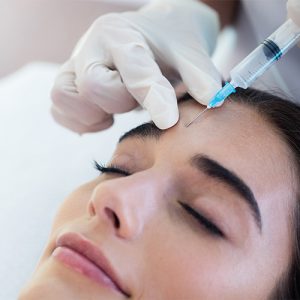By now we’ve all heard about PRP (Platelet Rich Plasma) and its regenerative abilities. While it is still widely used in several different branches of medicine, there’s a new generation of stem cell therapy, PRF (Platelet Rich Fibrin), and we’re using it in advanced aesthetics!
Your blood contains four main ingredients: red and white blood cells, platelets, and plasma. The platelets are largely responsible for clotting your blood and initiating the healing process any time you’re injured. Fueling the healing response are the growth factors and other proteins found in your platelets, which are released at the site of the damage in order to aid in healing, help with repairs, and reduce inflammation, all at a cellular level.
Platelet Rich Fibrin (PRF) vs Platelet Rich Plasma (PRP)
PRP is spun down at a very high speed, seperating all of the cells from the plasma, or liquid portion, of the blood. This plasma does contain your own growth factors and some platelets, but due to the diluted concentration it dissipates quickly in the area being treated. It has come to be called “fools gold” in our industry because of its unpredictable or unsatisfying efficacy. PRP also contains additives or anticoagulants, such as heparin. This allows for the plasm portion to be used for a much longer time after being spun down so there’s less urgency to get it into the area being treated. Unfortunately, this anticoagulant doesn’t allow the platelets to stimulate the healing process to their full ability.
PRF is spun down at a much slower speed so the cells aren’t completely seperated. While this results in less volume of injectable liquid, the portion used is much more concentrated and rich in platelets and growth factors. PRF keeps the platelets enveloped in a fibrin meshwork which helps build a thicker, slower absorbing layer in the area being treated. When injected this creates a lovely “scaffolding” effect to the skin. Hence the “natural filler” term.
So now you might be thinking “what the heck is fibrin?” Fibrin, in basic terms, is what platelets bind to as they circulate throughout your blood. When platelets bind to fibrin they release growth factors which help to start the healing process by creating new collagen, blood vessels, and skin cells in the process.
Also, PRF contains no anticoagulants or additives, making it a completely pure product, which is why we call it a “natural filler”.
The PRF product is spun at a lower speed so that the layers of the blood do not separate out as distinctly. This allows some of the white blood cells and stem cells to remain within the platelet layer that is collected for treatment. Thus, there are more healing factors within PRF than is typically seen in PRP. In addition, the lower spin speed causes less trauma to the individual cells of the blood, allowing more stem cells to remain in the final PRF product.
Book a Consultation with Accent Aesthetics today!
platelet rich fibrin, platelet rich fibrin, platelet rich fibrin

